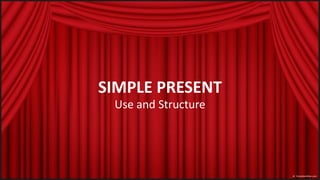
Simple present structure
- 1. SIMPLE PRESENT Use and Structure
- 2. Simple Present We use Simple Present to describe actions that are regular, normal or true. • Daily Routine (regular) • Habits (normal) • Facts (true)
- 3. Structure We form the Simple Present using the verb in the Infinitive Form (the root form of the Verb) Subject + Inf. Verb + Complement Ex. I speak english You live in a house
- 4. I write letters I sleep every night I eat carrots I dance on Saturdays I drink beer Structure
- 5. Structure In the 3rd singular person (He, She, It) we add –S at the end of the verb. Ex: She works in an office He reads the newspaper It plays with a ball
- 6. Simple Present lives She ______ in Japan. He ______ reads the newspaper. She ______ coffee. He ______ in a Restaurant. drinks works
- 7. Structure For Verbs that end in O – CH – SH – SS – X – Z we add - ES Go – Goes Watch –Watches Brush – Brushes Kiss - Kisses Fix – Fixes Buzz - Buzzes
- 8. Simbupzzlees Present The bee ______ around the flower. does He ______ the homework. washes She ______ the dishes. She _k_iss_e_s_ a frog.
- 9. Structure For Verbs that end in a consonant + Y we replace the Y with - IES Study – Studies Carry – Carries Worry – Worries
- 10. Simpclreie sPresent The baby ______ loudly. flies The bird ______ very high. dries She ______ her hair. studies She______ medicine.
- 11. Structure For Verbs that end in a vowel + Y we just add -S Play – Plays Buy – Buys Pay – Pays Enjoy – Enjoys
- 12. He ______ pays the bills every month. Simple Present buys She______ flowers to decorate the house. She ______ enjoys reading very much. plays He______ the piano.
- 13. Activity Name all the actions the following people can do using different verbs. Ex: Anna eats many fruits She dries her hair everyday She cooks cupcakes Anna
- 16. Negative in Simple Present We use the auxiliary verb Don’t or Doesn’t with all Verbs, except To Be and Modal Verbs (can, will, etc). Subject + Don’t/Doesn’t + Inf. Verb + Complement Ex. I don’t speak Chinese She doesn’t eat fish
- 17. Don’t Don’t is the contraction of DO + NOT I eat You don’t speak We study They read
- 18. Doesn’t Doesn’t is the contraction of DOES + NOT He live She doesn’t* work It sleep * The –S at the end of the verb goes to the auxiliary
- 19. Activity 2 According to the pictures, mention actions you never do using “DON’T”. Ex: I don’t watch TV in the afternoon.
- 21. Activity 3 According to the pictures, mention actions Peter never does using “DOESN’T”. Ex: Peter doesn’t eat oranges
- 23. Questions in Simple Present We use Do-Does to ask questions in Simple Present. I He Do You Does She We It They
- 24. Questions in Simple Present Do/Does + Subject + Inf.Verb + Complement Do you speak italian? Does she drink coffee? Do they work together? * We DON’T use DO or DOES in questions that have the verb To Be or Modal Verbs (can, will, etc)
- 25. Short Answers with Do & Does In direct questions that use DO and DOES it’s possible to give short answers. Sample Questions Affirmative Negative Do you like chocolate? Yes, I do No, I don’t Does she have a car? Yes, she does No, she doesn’t Do they eat pizza? Yes, they do No, they don’t
- 26. Open Questions in Simple Present We start the question with a WH WORD Wh Word + Do/Does + Subject + Inf. Verb + Complement Where do you live? What do you do in your free time?
- 27. Activity 4 Ask questions according to the pictures, using “DO” or “DOES”. Ex: Do you like japanese ramen?
- 29. Activity 5 Find the mistakes in the following sentences. 1. I works everyday in my office 2. She don’t speak chinese very fluently. 3. Children eating lots of candies in Halloween. 4. Gerry cook delicious italian and mexican food. 5. My best friend and I doesn’t go to the gym everyday. 6. You no have lunch at 12:00. You usually eat at 14:00 pm. 7. My dog play with children because is very friendly. 8. Mary does wear black clothes?
- 30. That’s it for today!
- 31. Extra Activity Find the Infinitive Verbs in the Word Search Puzzle (24)
